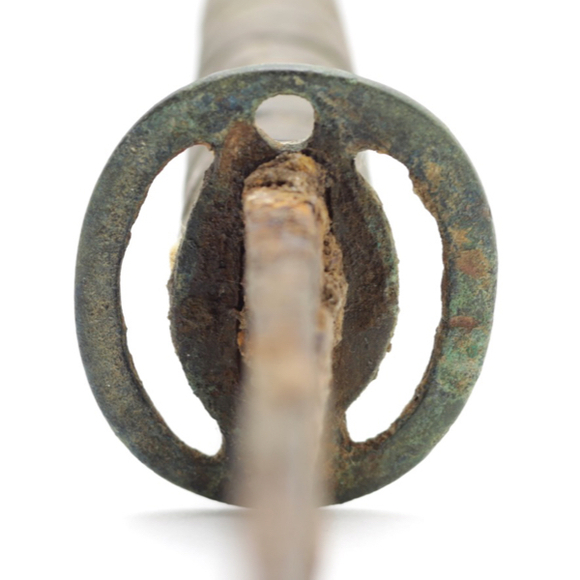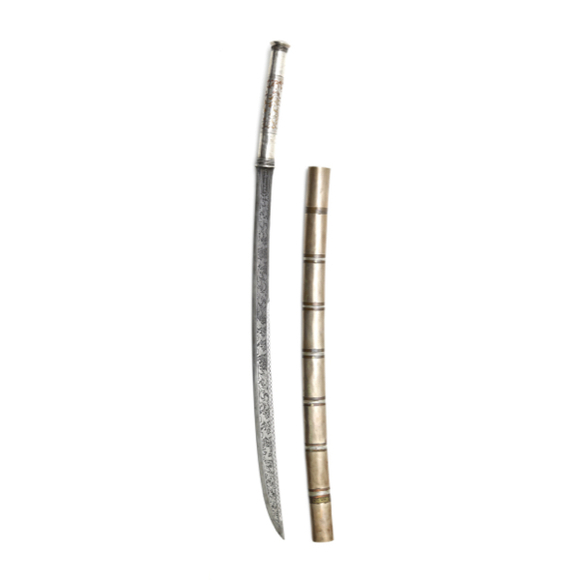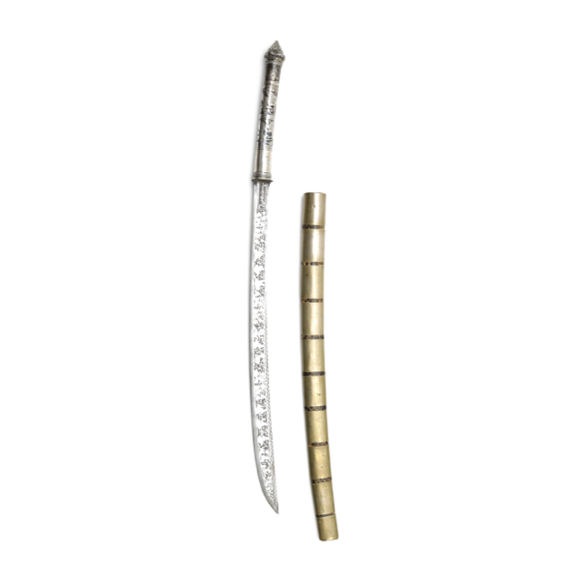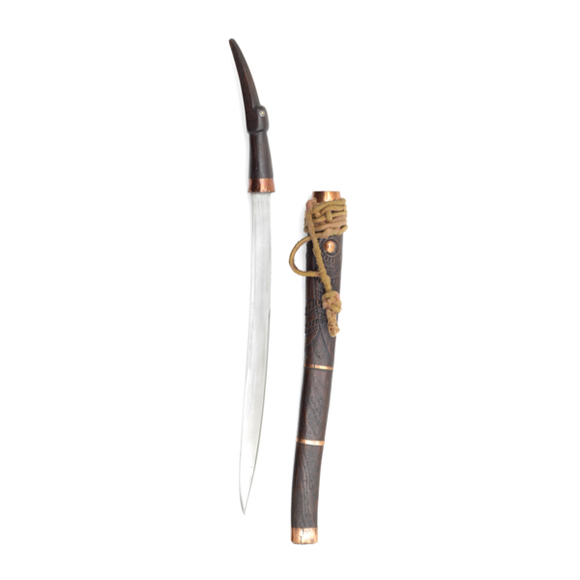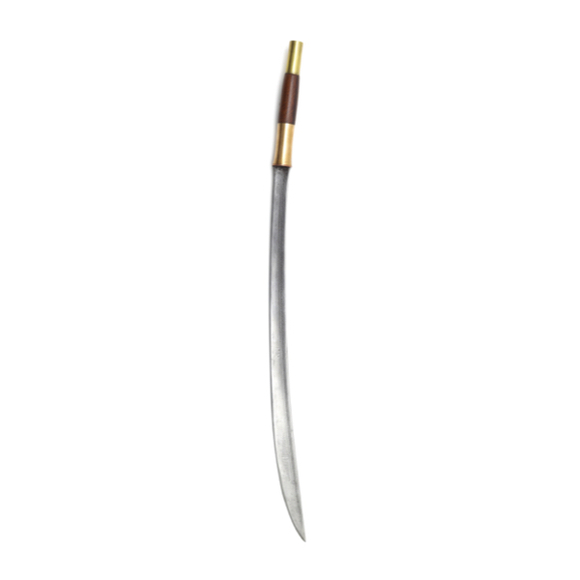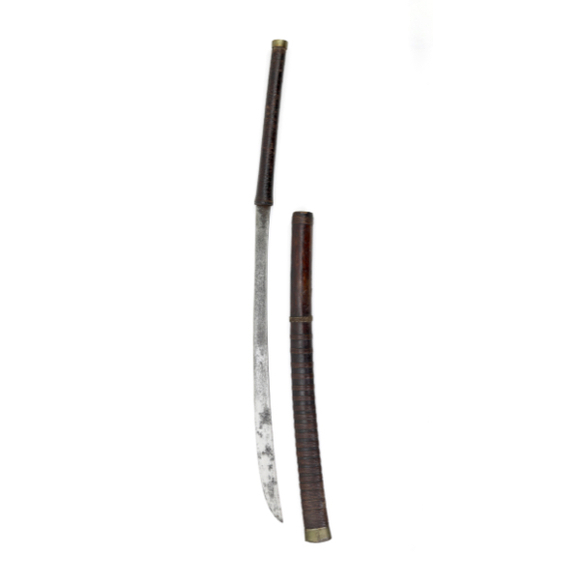In excavated condition, with copper alloy hilt.

Sheathed 85.3 cm
Sword 82.5 cm
61.4 cm
Base 9 mm
Middle 5.5 mm
5 cm from tip 4 mm
Narrowest at base 27 mm
Widest towards tip 34.5 mm
889 grams
11 cm from hilt
Iron, steel, wood, silver, resin, white metal alloy, brass, lacquer
Mindan village, Yamethin district
Burma
Circa 1880-1900
Introduction
Mindan is a village in Yamethin district, just south of Mandalay. It was known for its industry of making fine dha with fine silver overlay.
"The inlaid dha and dagger blades of Mindan near Yamèthin are well-known.
The dhas are inlaid in gold, silver and brass."
-Gazetteer of Upper Burma and the Shan states. 1901.
The most thorough account on their work is Bell's monograph on Iron and Steel production in Burma:
"This industry is said to have had its origin five generations before Saya Lan whose son Saya Pyo, the chief local artist, turned out the articles shown in the illustrations. The originator's name is forgotten, but the art is traditional, from father to son, each improving on his ancestors, as Saya Lan himself said:
"I was better than my father, and now my son, Maung Pyo, is better than I ever was."
-E.N. Bell; A Monograph on Iron and Steel Work in Burma. Rangoon, 1907.
Description
A fine example. Its blade of typical form, gently widening towards the tip and with a flat spine and long back bevel. It still retains its original edge finishing, which was traditionally done with river stones.
The center panel of the blade is slightly hollow ground, scored to receive the silver overlay, and then blackened for contrast. The designs are executed with more skill and precision than is normally seen.
The hilt is covered with silver plating and has a domed pommel.
Iron hilt overlay
Unusual and so far unique to this piece among the many Mindan dha I've studied is that the center section of the hilt is made of iron, and decorated with the same type of overlay as seen on the blade. The work shows the same skill and style of execution as the blade.
Scabbard
The scabbard is the usual format, made of wood covered with low-grade silver alloy plating, 17 segments in total on this one. Between the segments are brass wires in lacquer. There is a crack in the last segment that serves as a chape, see photos.
I believe these scabbards were not made by the makers of the swords, as there always tends to be quite a difference in quality with the fine work on the blades, yet almost all Mindan dha come with these scabbards and so these scabbard makers couldn't have been far from the Mindan sword maker's shops.
This dha presents two separate stories, one on the blade and one on its hilt.
The stories
Both stories are quite obscure and it took me some time to find information about them.
The hilt
The story of the hilt consists of two tiers, with three figures each. In the top tier we see someone pulling the hair of another figure, presumably anticipating to chop his head off. The second tier is not any less disturbing with what looks like a skewered baby.
This is the story of the thief Thilat (ထိလတ်), who wanted to be as great as his famous master. In order to create a potion to make himself invisible, he skewered and grilled his own son, after which the villagers killed him. After this, Thilat is thought to have become a spirit.

Upper tier:
ဘိုထိလပ် မပိုးအူဖမ်းပုံ ၊ တပည့်သကောင်ဘိုး ၊ မပိုးအူ
"Bo Ti Lat chasing Ms.Poe Oo", "The subordinate Tha Kaun Bo", "Ms.Poe Oo"
Lower tier:
သူကြီးမင်း ဘိုထိလတ်ဖမ်းပုံ ၊ ထိလတ်
"The headman chasing Bo Ti Lat", "Ti Lat"
The blade
The blade portrays the story of Prince Bindusara (ဗိန္ဒုသာယမင်းဇတ်ပုံ).
A historical figure, he would become emperor of India between 297-273 BCE. Most of the stories of his life though are semi-legendary and appear in Jain texts as well as the Sinhalese chronicles Mahavamsa.
According to this book, his father's advisor accidentally poisoned his pregnant mother only seven days before she would have gone into labor. To save the baby, they cut her open and removed the fetus, which was inserted into a freshly killed goat each of the next seven days. When the prince was "born", he was covered with drops of goat blood and was called Bindusara; "the strength of the drop".
The story on the dha is clearly another part of his life, as there appears to be a lot of talks but no goats involved.





















Fine silver overlaid dha made in Mindan village, south of Mandalay, gained fame in the 19th…

